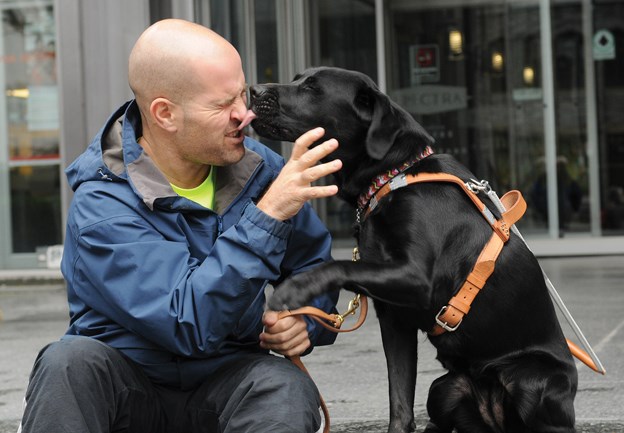Where Mark Bentz goes, Mindy goes.
From his home in North Vancouver to his job at a downtown health clinic, from Starbucks runs to workouts at the YMCA, Bentz is accompanied by his new guide dog, a 19-month-old black Lab.
Bentz has a progressive retinal degenerative condition that has left him with only two per cent of his vision. He’s used a guide dog for almost 10 years. When his previous canine companion, Victor, reached retirement age, he quickly found a successor in Mindy, who graduated last month from the B.C. & Alberta Guide Dogs training program.
“She’s pumped to work, loves to work, just can’t get enough of it,” Bentz says. “I pull that harness out, she’s doing back flips.”
Mindy is off the clock at home, but out in public she’s working to get Bentz from point A to point B safely and without bumping into any obstacles.
“The guide dog’s main goal is to get you around things, so that’s what she does, she drags me around things.”
Bentz is a 1984 Paralympic gold medalist in alpine skiing and maintains an active lifestyle that includes rowing and playing for a blind ice hockey team. Before he used a dog, he got around with a white cane. Making the switch has changed his life, he says.
“The white cane makes people nervous,” he says. “A dog makes people happy.”
Getting on the bus or walking into a store with his furry, four-legged guide makes it much easier to interact with people, and that’s important for a social person like Bentz.
“It’s fantastic, I should have got a dog way earlier in my life.”
Mindy lived with a puppy raiser on Vancouver Island until she was about 14 months old, at which point she moved in with a boarding family in the Lower Mainland while completing her formal training. Nick Toni, a guide dog mobility instructor with BC & Alberta Guide Dogs, recognized early on that Mindy might be a good match for Bentz.
“Mark works in the city centre, he’s a high-flying guy, he’s very fit and healthy and active. He needed a dog that was very positive and basically just got on with the job and could work in the busier city conditions,” Toni says.
For three weeks prior to graduation, Mindy engaged in domiciliary training, meaning she trained in Bentz’s home environment and got familiar with his day-to-day life.
It can take two years and upwards of $35,000 to breed, raise and professionally train one dog. But there’s no cost to the recipient. BC & Alberta Guide Dogs and its sister charity, Autism Support Dogs, rely on donors and volunteers.
Toni says each puppy is carefully assessed to ensure it is well-adjusted and able to cope with formal training.
“Some dogs do come in with slight issues, but in their three or four months training after that we can iron those things out,” he says. “We’re going to put somebody’s life in a dog’s hands at the end of the day, so it’s got to be right.”
Bentz says he leads “a pretty normal life.” He has limited sight, works a regular job, has hobbies and friends. But for some visually impaired people, he says, establishing relationships and socializing can be a huge challenge.
“For blind people, it can be so isolating,” he says. “(Guide dogs) just open up all these doors for you and just make your life easier.”



